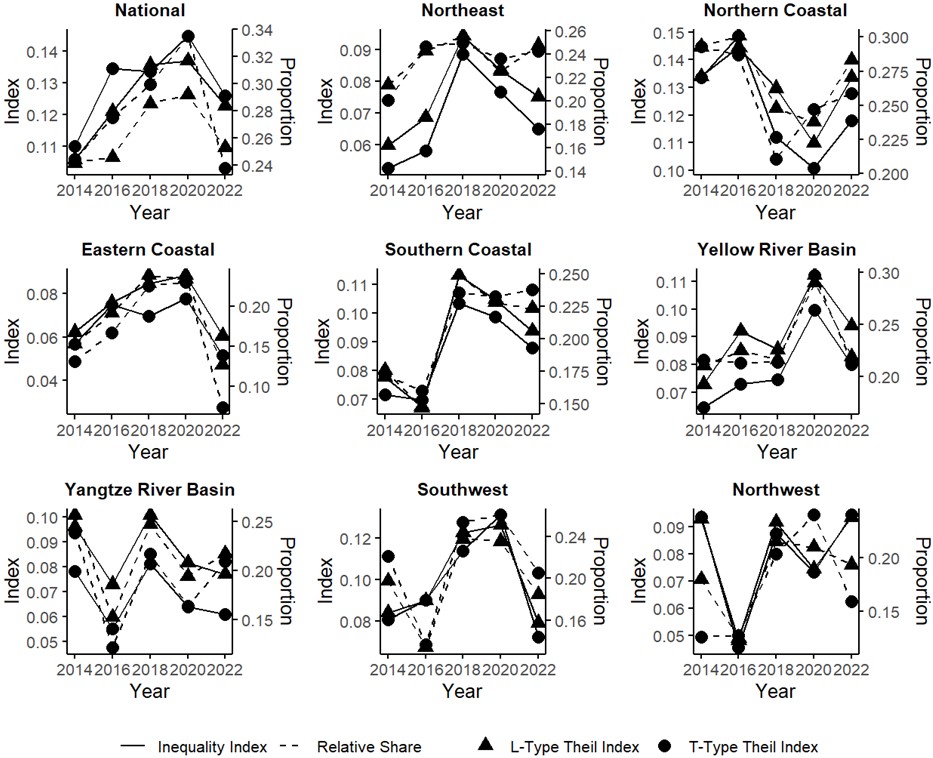Measurement and Analysis of Opportunity Inequality in Residents' Income
Abstract
Based on data from the China Family Panel Studies (CFPS), this study employs a parametric method to measure the degree of opportunity inequality in residents' income. It analyzes the spatial distribution characteristics across eight regions and delves into the contribution mechanisms of grouped environmental variables to income inequality. The empirical findings reveal that family environment factors consistently serve as the core driving force behind income opportunity inequality, with a persistently stable and significant contribution, underscoring the enduring impact of intergenerational transmission. Regional environmental factors exhibit significant fluctuations in their contributions, which are closely synchronized with the evolution of the overall inequality index, highlighting the pivotal role of regional development disparities in shaping inequality patterns. The contribution of individually controllable factors shows a gradual upward trend, providing a buffering effect, particularly during phases of declining opportunity inequality. Overall, the influence of environmental groupings on income inequality is characterized by a three-dimensional dynamic pattern of "family dominance, regional fluctuation, and individual enhancement."
References
Dong, L. (2025). Wealth opportunity fairness and common prosperity: Measurement and decomposition based on opportunity inequality. Economic Theory and Economic Management, 45(02), 75–95.
Ferreira, F. H., & Gignoux, J. (2011). The measurement of inequality of opportunity: Theory and an application to Latin America. Review of Income and Wealth, 57(4), 622–657. https://doi.org/10.1111/j.1475-4991.2011.00467.x
Fleurbaey, M. (1955). Three solutions for the compensation problem. Journal of Economic Theory, 65(2), 505–521. https://doi.org/10.1006/jeth.1995.1018
Kranich, L. (1996). Equitable opportunities: An axiomatic approach. Journal of Economic Theory, 71(1), 131–147. https://doi.org/10.1006/jeth.1996.0112
Lefranc, A., Pistolesi, N., & Trannoy, A. (2008). Inequality of opportunities vs. inequality of outcomes: Are Western societies all alike? Review of Income and Wealth, 54(4), 531–546. https://doi.org/10.1111/j.1475-4991.2008.00289.x
Lei, X., Jia, Y., & Gong, F. (2018). Measurement of opportunity inequality: Application and improvement of parametric measurement methods. Statistical Research, 35(04), 73–85.
Li, J., & Hao, X. (2019). Measurement of opportunity inequality: Application and comparison of regression tree models. Statistics and Information Forum, 34(10), 3–13.
Li, Q., Nie, P., Xu, B., et al. (2025). The impact of income opportunity inequality on Chinese residents' mental health. Population and Development, 31(01), 70–79.
Peng, J., & Zhao, X. (2024). Measurement and mechanism study of intergenerational income mobility between urban and rural areas in China. Statistics and Information Forum, 39(07), 112–128.
Roemer, J. E. (1993). A pragmatic theory of responsibility for the egalitarian planner. Philosophy & Public Affairs, 146–166.
Roemer, J. E. (1998). Equality of opportunity. Cambridge, MA and London: Harvard University Press. https://doi.org/10.4159/9780674042872
Sun, S., Zhang, Q., & Li, R. (2023). Measurement and source identification of wealth opportunity inequality in China: Discussion on the path choice for common prosperity. Financial Research, (11), 97–114.
Van De Gaer, D. F. G. (1993). Equality of opportunity and investment in human capital (Ph.D. dissertation). University of Leuven.
Wan, X., Zhang, C., & Tang, L. (2024). Re-estimation of income opportunity inequality of Chinese residents: New findings from machine learning. Quantitative Economics and Technical Economics Research, 41(01), 192–212.
Wu, S., & Luo, C. (2025). Opportunity inequality in income gaps and its dynamic changes. Journal of Xiangtan University (Philosophy and Social Sciences Edition), 49(01), 64–71.
Yang, B., Liang, Z., Yi, X., et al. (2024). Mechanism and effects of opportunity inequality on residents’ consumption: An empirical study based on CFPS data. Nankai Economic Studies, (03), 20–40.
Yang, J., & Zhang, L. (2024). Changing trends of educational inequality in China: A perspective based on opportunity inequality. Education Economics Review, 9(06), 3–26.
Yang, Z., & Sun, X. (2024). Opportunity inequality in rural residents’ income gaps in China. Journal of South China Agricultural University (Social Science Edition), 23(01), 35–47.
Zhang, M., Bian, S., & Chen, Y. (2023). The impact of opportunity inequality on employment level and employment hierarchy. Population Journal, 45(05), 83–96.
Zhang, T., Guo, Z., & Li, X. (2024). Can the digital economy reduce income opportunity inequality? Empirical evidence from Chinese cities. Journal of Shanxi University of Finance and Economics, 46(09), 28–40.


This work is licensed under a Creative Commons Attribution 4.0 International License.
Copyright for this article is retained by the author(s), with first publication rights granted to the journal.
This is an open-access article distributed under the terms and conditions of the Creative Commons Attribution license (http://creativecommons.org/licenses/by/4.0/).









1.png)














